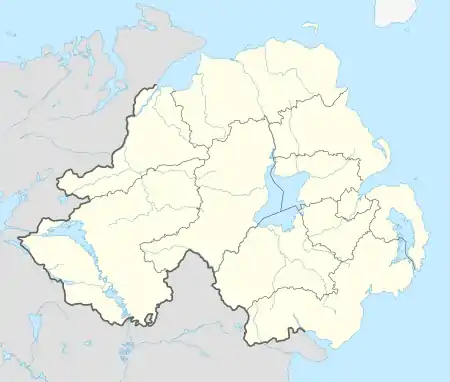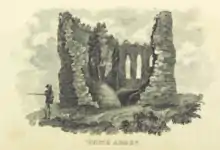Whiteabbey
Whiteabbey is a townland (of 406 acres) in Newtownabbey, north of Belfast in County Antrim, Northern Ireland.[2]
Whiteabbey
| |
|---|---|
 A row of houses on the Shore Road, Whiteabbey | |
 Whiteabbey Whiteabbey shown within Northern Ireland  Whiteabbey Whiteabbey (the United Kingdom) | |
| Coordinates: 54°40′27″N 5°53′58″W | |
| Sovereign state | United Kingdom |
| Country | Northern Ireland |
| County | Antrim |
| Barony | Belfast Lower |
| Civil parish | Carnmoney |
| Settlements | Newtownabbey |
| Government | |
| • Council | Newtownabbey |
| Area | |
| • Total | 370.79 acres (150.05 ha) |
The original village of Whiteabbey stood at the foot of the Three Mile Water, on the shore of Belfast Lough. In 1958, it and six other villages were joined to form the new district of Newtownabbey. Whiteabbey is part of the civil parish of Carnmoney and the historic barony of Belfast Lower.[1][2]
History

Whiteabbey took its name from the medieval abbey of Druim La Croix, which stood near present-day Whiteabbey Hospital. The abbey was a daughter house of Dryburgh Abbey in Scotland and belonged to the Premonstratensian Order, who were popularly known as the White Canons. Parts of the ruined chapter house remained visible until the 20th century, but the last traces of the building were removed in 1926.[3]
In the first half of the 19th century, the village of Whiteabbey was home to a large bleach works, and was an important landing site for coal shipments bound for Belfast. Remnants of the old pier can still be seen in Belfast Lough. The importance of Whiteabbey declined after the channel into Belfast Harbour was widened and straightened, allowing larger ships to reach the city directly.
Abbeylands, a Victorian house in Whiteabbey belonging to Sir Hugh McCalmont, was used as a training ground by the Ulster Volunteers during the Home Rule Crisis. In 1914, the building was torched by Suffragettes in response to Edward Carson's opposition to votes for women, causing £20,000 of damage.[4][5]
In 1952, one of Northern Ireland's most controversial murders took place in Whiteabbey when Patricia Curran, the 19-year-old daughter of prominent judge and politician Sir Lancelot Curran, was found stabbed near her home, Glen House.[6]
Whiteabbey, together with Whitewell, Whitehouse, Jordanstown, Monkstown, Carnmoney, and Glengormley, were the seven villages that formed Newtownabbey when it gained district council status on 1 April 1958.
Local facilities
- The Glen, which follows the Three Mile Water up to the Bleach Green railway viaducts, is a popular local walking route.
- Whiteabbey Hospital is located near the village.
- Whiteabbey is close to the main shopping area of Newtownabbey, including the Abbey Centre.[7]
Local Schools and Education
- Northern Regional College
- Ulster University - Jordanstown Campus
- Whiteabbey Primary School
- St James's Primary School
- King's Park Primary School
- Rostulla Special School
- Thornfield House School
Local Churches
- Whiteabbey Congregational Church
- Whiteabbey Presbyterian Church
- Whiteabbey Methodist Church
- Saint James Catholic Church
- The Church of Jesus Christ of Latter-day Saints, Newtownabbey
Transport
The area is served by Whiteabbey railway station on the Belfast to Larne line. The station opened in April 1848.[8] Although it lies outside Belfast, the area is also served by the Translink Metro service.[9]
See also
References
- "Whiteabbey". Placenames Database of Ireland. Retrieved 12 April 2015.
- "White Abbey". IreAtlas Townlands Database. Retrieved 12 April 2015.
- "Whiteabbey". The Northern Ireland Place-Names Project.
- "The Women's Suffrage Movement" (PDF). NI Assembly Education. Retrieved 16 April 2015.
- "A role in Home Rule". Irish Times. Retrieved 16 April 2015.
- "Patricia Curran murder case".
- Abbey Centre
- "Whiteabbey station" (PDF). Railscot - Irish Railways. Retrieved 2007-08-28.
- Translink Metro 2
| Wikimedia Commons has media related to Whiteabbey. |
